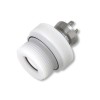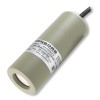Millimeters of Water Column is a low range metric pressure unit derived from the hydrostatic pressure of 1mm head of water at 4 degC. 1 millimeter of water gauge equals 9.80665 pascals.
The mmH2O pressure unit is used for monitoring low air flow pressures used in building ventilation systems or very low water levels in rivers and streams. Historically low air pressures were measured using water column manometers but although these instruments have been mostly replaced by digital manometers which use electronic sensors, the mmH2O pressure unit remains in use.
For more background information on metric water column pressure units please go to our mH2O page.
To find the equivalent pressure value of 1 mmWC in other units please use the list below.
Click on the applicable unit below to obtain the conversion factor for converting into Millimetres of Water Column.
Use the site pressure converter to calculate many different readings in mmWG.
Go to the section which shows how mmH2O is derived from SI units or verify the list of the description variations for mmH2O.
Conversion Factors
- 0.0000980665 bar
- 0.00142233 psi
- 0.0980665 mbar
- 9.80665 N/m²
- 9.80665 Pa
- 0.0980665 hPa
- 0.00980665 kPa
- 0.00000980665 MPa
- 0.0001 kg/cm²
- 1 mmH2O 4°C (39.2°F)
- 0.1 cmH2O 4°C (39.2°F)
- 0.001 mH2O 4°C (39.2°F)
- 0.0393701 inH2O 4°C (39.2°F)
- 0.00328084 ftH2O 4°C (39.2°F)
- 0.0735559 mmHg 0°C (32°F)
- 0.00735559 cmHg 0°C (32°F)
- 0.00289590 inHg 0°C (32°F)
- 0.0735559 Torr
- 73.5559 mTorr
- 0.0000967841 atm
- 0.0001 at
- 98.0665 dyn/cm²
- 0.0227573 oz/in²
- 73.5559 µHg 0°C (32°F)
- 0.000000634971 tsi (uk, long)
- 0.000000711167 tsi (usa, short)
- 0.000102408 tsf (usa, short)
- 0.204816 psf
- 0.1 g/cm²
Please note that the conversion factors above are accurate to 6 significant figures.
Derivation
The calculation below shows how the pressure unit Millimetres of Water Column (mmH2O) is derived from SI Units.
Formula
- Pressure = Force / Area
- Force = Mass x Acceleration
- Mass = Density x Volume
- Volume = Area x Height
- Acceleration = Distance / (Time x Time)
SI Units
- Mass: kilogram (kg)
- Length: metre (m)
- Time: second (s)
- Force: newton (N)
- Pressure: pascal (Pa)
Input Values
- Density = Water Density at 4degC = 1000 kg/m³
- Area = 1 m²
- Height = 1 mm = 0.001 m
- Acceleration = Standard Gravity = 9.80665 m/s²
Calculation
- 1 mmH2O Mass = 1000 kg/m³ x 1 m² x 0.001 m = 1 kg
- 1 mmH2O Force = 1 kg x 9.80665 m/s² = 9.80665 N
- 1 mmH2O Pressure = 9.80665 N / 1 m² = 9.80665 Pa
Alternate Descriptions
These are the different versions used for identifying mmH2O that you may find elsewhere.
- Millimetres of H2O
- Millimeters of H2O
- Millimetres of Water Column
- Millimeters of Water Column
- Millimetres of Water Gauge
- Millimeters of Water Gauge
- mmH2O
- mmWC
- mmWG
- mmWS
- mmAq
- mm H2O
- mm WC
- mm WG
- mm WS
- mm Aq
Conversion Tables
Select a look up table for converting a pressure reading in millimetres of water column to other measurement units.
- mmHg » 1 to 10,000 mmH2O → 0.0735559 to 735.559 ftH2O
- Pa » 0.1 to 100 mmH2O → 0.980665 to 980.665 Pa
Help
mmAq meaning
Please could you explain what type of pressure unit is mmAq and what 8.0 mmAq equals?
mmAq is the abbreviation for the pressure unit Millimetres of Aqua which is the same as Millimetres of Water (mmH2O). Therefore 8.0 mmAq is the hydrostatic pressure generated by water 8 mm deep.
mmH2O to square root 4-20mA & %FS
How do you convert a mmH2O pressure reading to a square root 4-20mA output and also the equivalent percentage of full scale for a differential flow transmitter?
First you will need to use this tool to define the pressure range and calculate the square root extraction mA output. Enter the mmH2O pressure reading into the measurement reading and then the lowest and highest possible measurement in mmH2O units to calculate the square root mA signal.
Then you will need to use this other tool to convert the mA signal to the equivalent percentage of full scale. Enter the square root mA output as the reading input, 4mA as the lowest input and 20mA as the highest input, then enter 0 into the lowest output and 100 into the highest output.
mmH2O application
Why is millimeter of water column used to measure pressure?
A liquid column head of water generates hydrostatic pressure and this principle is commonly utilised in U tube water column manometers where the difference in water level between each side is measured in millimetres or inches.
These U tube manometers are a very convenient and simple way to measure very low pressures such as those found in air ventilation systems, particularly before electronic sensors became more widespread.
So as electronic instrumentation is slowly replacing these water column manometers the users require them to be calibrated in the same units such as millimetres of water or inches of water.
Millimeter of water column pressure units are also used for converting the hydrostatic pressure measured in shallow water depths of rivers, streams and weirs.
Glossary of Liquid Level technical terms
- Capacitive Fluid Level Measurement
- cmH2O – Centimetres of Water Column at 4 deg C Pressure Unit
- Conductive Fluid Level Detection
- Float Fluid Level Detection
- ftH2O – Feet of Water Column at 4 deg C Pressure Unit
- mH2O – Metres of Water Gauge at 4 deg C Pressure Unit
- Specific Gravity
- Vibrating Tuning Fork Fluid Level Detection
Help from Liquid Level resources
- Measuring the volume of liquid in a horizontal cylinder tank
- Determining water tank volume using hydrostatic pressure
- How do you measure the volume of a liquid using pressure
- Calculating required pressure range for fuel tank level measurement



